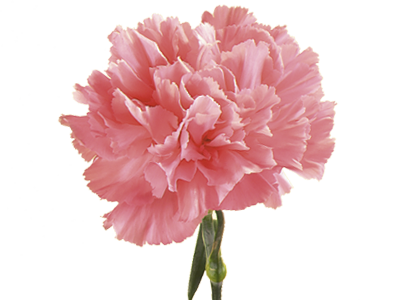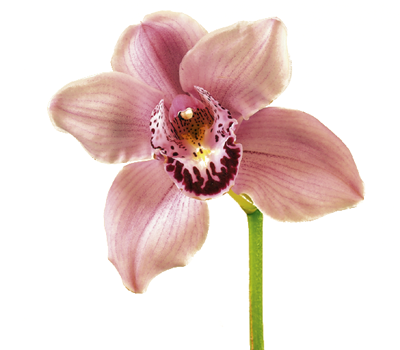Botany is the branch of biology that deals with plants. It involves the study of the structure and properties of plant life, including flowers and trees. Also included are plant classification and the study of the interactions of plants with their physical environment. Botany traces back to the ancient world but received its modern impetus in the 16th century. Not until the 18th century did we have the rules that we follow today of binomial nomenclature, i.e. the naming of each species by two words, of which the first is the name of the genus to which it belongs and the second is a decriptive or species name.
Flower biology acquaints us with many common characteristics of flowers, such as where they are grown, seasonality, blooming characteristics, fragrances and personality, as well as any nutritional and medicinal values they might offer.
The sole function of the flower is sexual reproduction. Its attractiveness and fragrance ensure the continuance of the plant species. Fragrance and color are devices to attract pollinators, such as birds and bees, that play an important role in the reproductive process.
Most flowers have both male and female reproductive organs. Botanists refer to them as "perfect". Examples; roses, morning glories, snapdragons, petunias, irises and lilies. Botanists call flowers that contain only one sex organ "imperfect."
FEMALE: The pistil is the female part of the plant.
Generally shaped like a bowling pin and located in the center of the flower. It consists of the stigma, style, and ovary. The stigma is located at the top, and is connected to the ovary by the style. The ovary contains the eggs which reside in the ovules. After the egg is fertilized the ovule develops into a seed.
MALE: The stamen is the male reproductive organ.
Consists of a pollen sac (anther) and a long supporting filament. This filament holds the anther in position so the pollen it contains may be disbursed by wind or carried to the stigma (female part) by insects, birds or bats.
SEPALS: small green, leaflike structures on the base of the flower which protect the flower bud. The sepals collectively are called the calyx.
PETALS: are highly colored and may contain perfume as well as nectar glands. The petals collectively are called the corolla.

Carnations are flowers which are widely recognized by most people. They are classified as Dianthus caryophyllus, when translated, means "flower of love" or "flower of the gods". There are approximately 300 species in the genus. They are native to the Eastern Hemisphere and are found naturally in the Mediterranean region, although modern varieties are grown both in greenhouses and in fields around the world. With such widespread commercial production available, there is not a limited season of availability. Because of their long lasting qualities and fragrance, carnations are often featured in arrangements at holidays celebrated with flowers, at special occasions such as weddings and parties, and in sympathy arrangements.
Essential carnation oil in its absolute form is both rare and expensive. Many varieties produce a clove-like scent, and the aroma is said to be both uplifting and motivating. Not only are people attracted by their scent, but carnations also have an extended enjoyment period of anywhere from 7 to 21 days depending on the cultivar, harvest stage and flower food.
Many of the commercially produced varieties have flowers up to 3 inches in diameter. Most flowers are double forms with ruffled petals.
To date, there are no medicinal values associated with carnations, however they have been used in candy and cocktails and to make a certain liqueur.

All varieties of orchids make up the Orchidaceae family. They have been discovered growing on every continent except Antarctica. Orchids thrive in elevations from sea level to 15,000 feet. The greatest number of orchid species is found in tropical regions. The majority of orchids are epiphytes – meaning they grow on top of or attached to another living plant – not parasites as once thought. They obtain their nutrients through the spongy epidermis of their roots.
Many orchids produce a sweet fragrance, which attracts a wide range of pollinators such as birds, bees, flies and even ants.
Since orchids are grown in many different locations around the world, most varieties do not have a limited season of availability. There are nearly 30,000 varieties, but the most common are Dendrobiums, Cymbidium, Cattleya, Phalaenopsis and Vanda. Because of their more limited commercial production, orchids are generally used in event work, such as weddings, parties and upscale occasions. Each type of orchid has its own personality. Dendrobiums are often used as cut flowers in tropical arrangements, while Cymbidium orchids were once thought of as the Mother’s Day corsage orchid, making it a commonly recognized variety. Cattleya orchids were the popular choice of brides during the 40s and 50s, but Phalaenopsis (or Butterfly) orchids are the choice for modern arrangements because of their simplicity and elegance. Some orchids are edible and are used as garnish in culinary presentations.
Vanilla is one of the rare examples of orchids being used for food. Both the seeds and surrounding pulp within the seed pod of the Vanilla orchid are used to make the extremely popular flavoring vanilla extract.

Roses are native to the temperate regions of the Northern Hemisphere. Most rose species are native to Asia, though some are native to North America, Europe or northwest Africa. Roses from different regions of the world hybridize readily. Of more than 100 species of roses, fewer than 10 species were involved in the crossbreeding that ultimately produced today’s many types of garden roses.
Roses are available year-round and are in high demand for Valentine's Day and Mother's Day. Many of today's commercially grown roses are produced in South America due to the nature of the climate. Long days of sun and temperate nights create an ideal growing condition. Although roses are still grown in North America, production has decreased due to the high costs of heating and cooling greenhouses.
Roses belong to the genus Rosa and are often considered to be one of nature's most fragrant flowers. However, due to hybridizing, roses range from having no fragrance smelling tea-like, spicy, musky, fruity or even citrusy. The oils produced by compressing rose petals are a valuable ingredient of fine perfumes and liqueurs, and are also used to flavor lozenges and scent ointments and toiletries.
Some fresh rose petals are edible and are used as garnish on salads and fruit trays. Petals are also used in jellies, vinegars, honeys, syrups and sorbets.
Medicinally, rose petals help to cool circulating blood and are useful in treating depression.
Cut roses can be enjoyed anywhere from 4 to 16 days depending on post-harvest care.

Sunflower plants are of the genus Helianthus, of the family Asteraceae, and are native to North and South America. They are an annual plant with availability year round, but the peak period of enjoyment is from June to October.
The blossom is actually a composite of multiple flowers crowded together, with "ray florets" forming the outer petals that surround a large brown or yellow disc. Their thick, leafy and hairy stems often grow more than 4 feet in height, although dwarf varieties are available for ornamental gardens.
Although a bright and attractive flower, the sunflower does not produce a fragrance. It does, however, have value from an economic and ornamental point of view. The leaves are used as fodder, the flowers yield a yellow dye, and the seeds have many uses in food, fuel etc. The yellow, sweet oil obtained by compression of the seeds is considered equal to olive oil for table use. The oil is also used in soap and paints and as a lubricant.
Many have found value in its medicinal uses for ulcers, canker sores, gum disease, sore throats and tonsillitis.

Tulips make up the genus Tulipa and are among the most popular of all garden flowers. This may be in part because of the wide range of colors available, with the exception of true blue. Almost 4,000 horticultural varieties have been developed.
The name tulip is the Latinized version of the Persian word "dulband" (turban), so called because of the flower's resemblance to a turban. Turkish men customarily wore tulips tucked in the folds of their turbans. Tulips were introduced to the Western world by a Dutch ambassador to Turkey in the 16th century.
Tulips blossom in early to late spring, depending on the climate in which they are planted. Cut tulips are primarily enjoyed during the same season, although they are now commercially grown to be available as a cut flower all year long.
Tulips continue to bloom annually for a few years but eventually degenerate. It is a common practice to lift the bulb (remove form the soil) after the flowers have dropped and the foliage has yellowed, and store them in a cool dry place until autumn replanting time.
Some tulips varieties have a slight fragrance. Some chefs consider the fresh petals of a tulip edible and use them in salads or on tea sandwiches. Tulips play an important role in nature. They are a harbinger that spring has sprung and the winter season is almost finished!